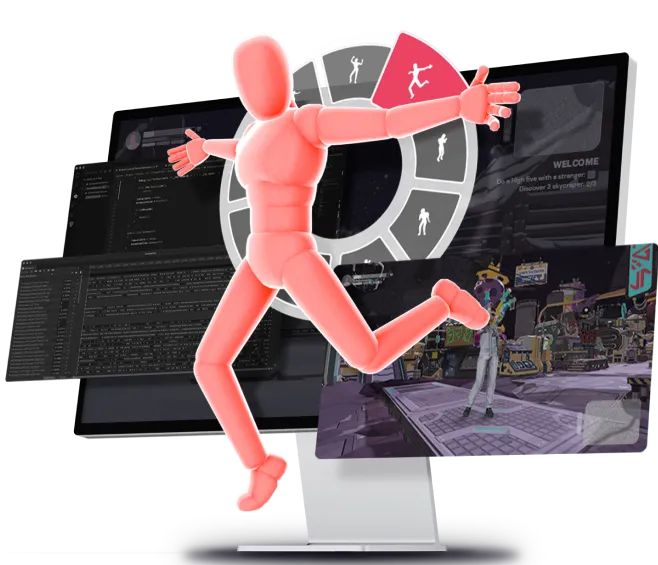How are emotes integrated into gameplay?
Let’s explore the fascinating journey of emote integration into gameplay.

Let’s explore the fascinating journey of emote integration into gameplay.
In the ever-evolving world of video games, the ability to convey emotions and reactions isn't confined to text or voice chat. Emotes, those delightful animations and gestures performed by in-game characters, serve as a universal language of expression. But have you ever wondered how these emotes seamlessly find their way into the gaming experience? Let’s explore the fascinating journey of emote integration into gameplay.
1. Calling emotes in-game: a gesture away
One of the key aspects of emote gameplay is the way players access and use them. There are several methods to call upon emotes in-game, each designed to suit different gaming experiences:
Standard Emote Buttons: These are the most straightforward emote triggers. A simple push of a designated button or key can make your character perform a pre-defined emote instantly. Whether it's a victory dance or a playful wave, standard emote buttons are your direct line to expressing emotions. This technique is particularly relevant in multiplayer games that do not include any form of social interactions, such as Super Smash Bros. and fighting games, or League of Legends and MOBAs. In these games, playable characters have their own set of emotes, and each emote is accessible through the push of a single button.
Emote Wheels: In games with extensive social interaction features such as Fortnite and Apex Legends, emote wheels provide players with a diverse selection of emotes. Gamers have the freedom to pick from a variety of options, whether it's a dance emote, a friendly greeting, or a humorous gesture, allowing them to express themselves while engaging with other players during intense gameplay moments. This kind of emote selection complements universes where players can customize their avatars, as emotes serve as extensions of players' expressions and their desire for personalization.

Contextual Emotes: These emotes are the chameleons of the gaming world. They automatically respond to in-game events, creating a seamless and responsive gaming experience. Your character might spontaneously cheer after a hard-fought victory, or cower in fear when faced with danger, all without your direct input. In Red Dead Redemption 2, the NPC’s reactions are context-sensitive: when the player approaches an NPC or another player, a wheel of emote options appears. These emotes include greeting, antagonizing, defusing a situation, and more. If the player approaches a friendly character, they might tip their hat, and if he antagonizes someone, a brawl might ensue. These automatic, contextual emotes make the game world feel alive and responsive.
2. Collecting emotes: a quest for expression
Emotes are not just about expression. They are exciting collectibles that forge the player’s identity. Game designers have devised a range of methods for players to collect emotes, adding a layer of excitement to the gaming journey:
In-Shop Purchases: Many games like Fortnite offer a marketplace where players can purchase emotes. Whether it's a celebratory dance or a funny jig, you can invest in these virtual expressions to personalize your gameplay experience. As presented in the previous article about Emote Monetization, these shops usually allow players to acquire emotes in exchange for virtual currencies that can be acquired with real-world money. Additionally, it is quite common for games to include emotes in Battle Passes and Premium random chests.
Exploration & Chests: Emotes can be hidden treasures, awaiting discovery within the game world. Sometimes, your character's victory might be rewarded with an exclusive emote, creating an element of surprise and delight. In The Elder Scrolls Online, players can discover and unlock emotes by exploring the game world and locating "Lorebooks" that are scattered throughout the world and contain knowledge related to the game's lore and story. When players find and read these books, they earn experience points and, in some cases, unlock associated emotes. The emotes may reflect the themes and stories found in the lorebooks.

Quest Rewards & Achievements: Game developers often include emotes as rewards for completing in-game quests or achieving an important milestone. This not only adds depth to the game's narrative but also motivates players to embark on new adventures and challenges. In The Elder Scrolls V: Skyrim, players can earn unique emotes as quest rewards. For example, completing the "Thieves Guild" questline rewards you with the "Night Mother's Embrace" emote, adding a touch of dark flair to your character's repertoire.
Conclusion
Emote integration in video game design is a testament to the ever-evolving nature of gaming. It's not just about animations; it's about creating a dynamic and expressive language that enhances storytelling, social interaction, and immersion. Whether you're celebrating a well-earned victory, consoling a friend, or responding to in-game events, emotes have become an integral part of your gaming adventure.
To help you integrate emotes into your game in the best possible way for your gameplay, Kinetix has developed great solutions that are part of the Kinetix SDK. Kinetix lets you choose from a large library of 1,000+ emotes and integrate them into your game in one-click. You can assign one or multiple emotes to an in-game slot (in-game shop slot, chest, quest reward,...) and schedule time-based rotations to regularly update the slot with the selected emotes. Using the library and this feature, you are able to deliver daily fresh emote content into your game and boost your game’s engagement.
Join our newsletter
With Kinetix's SDK & APIs, integrate an AI-powered User-Generated Emote feature in your game with just a few lines of code.



